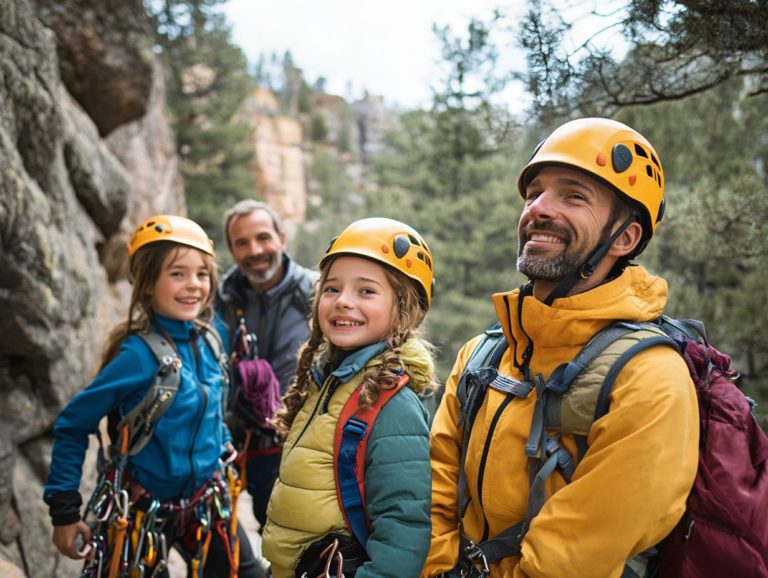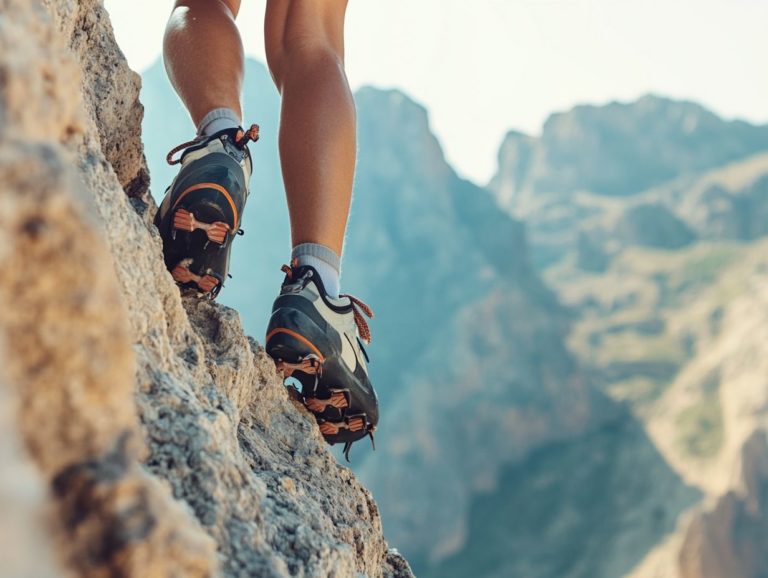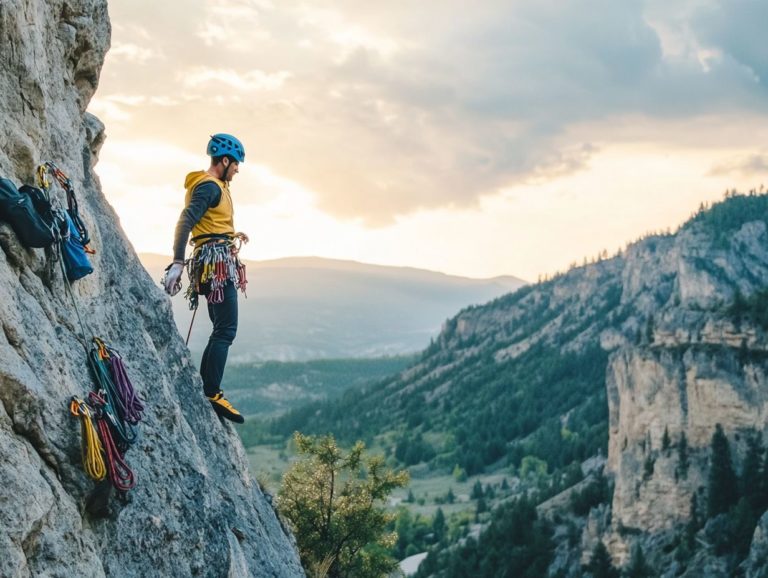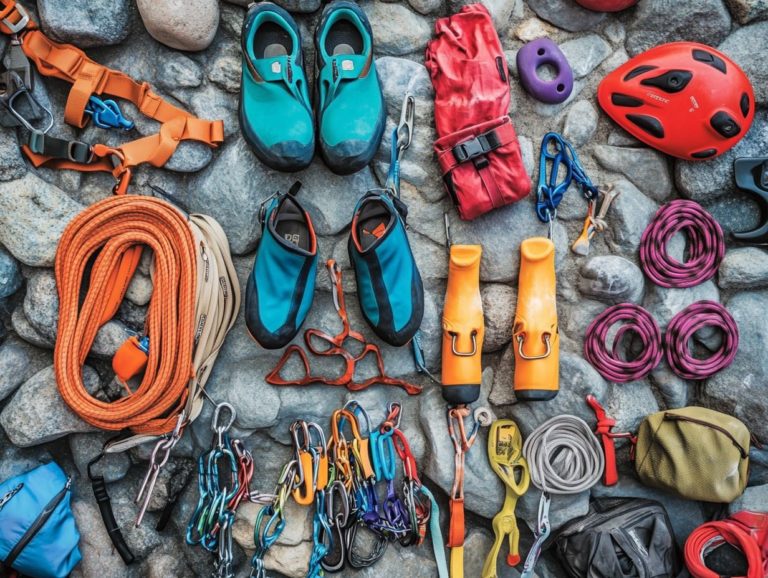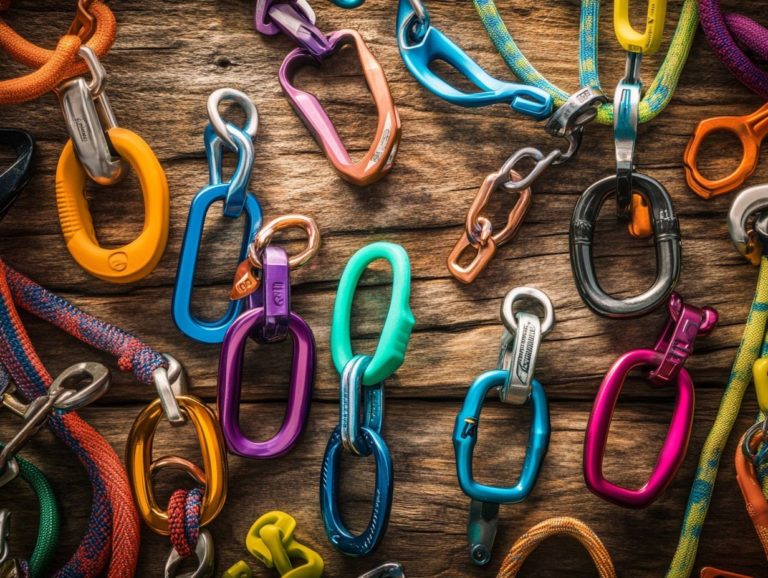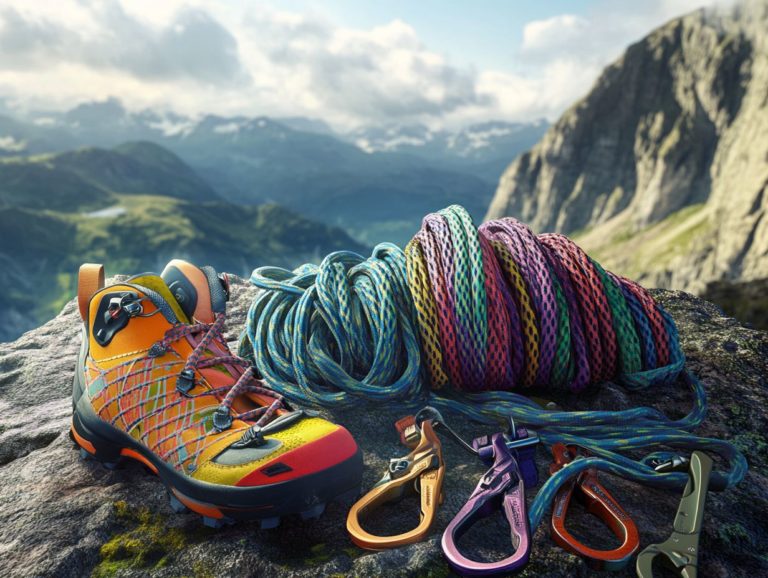The Best Climbing Gear for Outdoor Adventures
Embarking on an outdoor climbing adventure demands more than mere enthusiasm; having the right gear is essential for both safety and performance.
From climbing shoes that elevate your grip to harnesses that ensure your security, each piece of equipment is integral to your climbing experience.
This guide delves into the essential climbing gear and provides insights on selecting the perfect items tailored to your needs, ensuring you re thoroughly prepared for your next ascent.
Dive in to discover the must-have gear for a successful climb!
Contents
- Key Takeaways:
- 1. Climbing Shoes
- 2. Harness
- 3. Chalk Bag
- 4. Carabiners
- 5. Belay Device
- 6. Helmet
- 7. Quickdraws
- 8. Rope
- 9. Climbing Pants
- 10. Climbing Shirt
- 11. Climbing Backpack
- 12. Climbing Gloves
- 13. Climbing Tape
- 14. Climbing Helmet Light
- 15. Climbing Guide Book
- What to Consider When Choosing Climbing Gear?
- How to Determine the Right Size and Fit?
- What Are the Different Types of Climbing Shoes?
- What Are the Key Features of a Good Climbing Harness?
- How to Choose the Right Belay Device for Your Needs?
- What Are the Different Types of Climbing Helmets and Their Uses?
- What Are the Essential Features of a Climbing Backpack?
- How to Choose the Right Climbing Rope for Your Adventure?
- What Are Some Tips for Choosing Comfortable and Durable Climbing Clothing?
- Frequently Asked Questions
Key Takeaways:
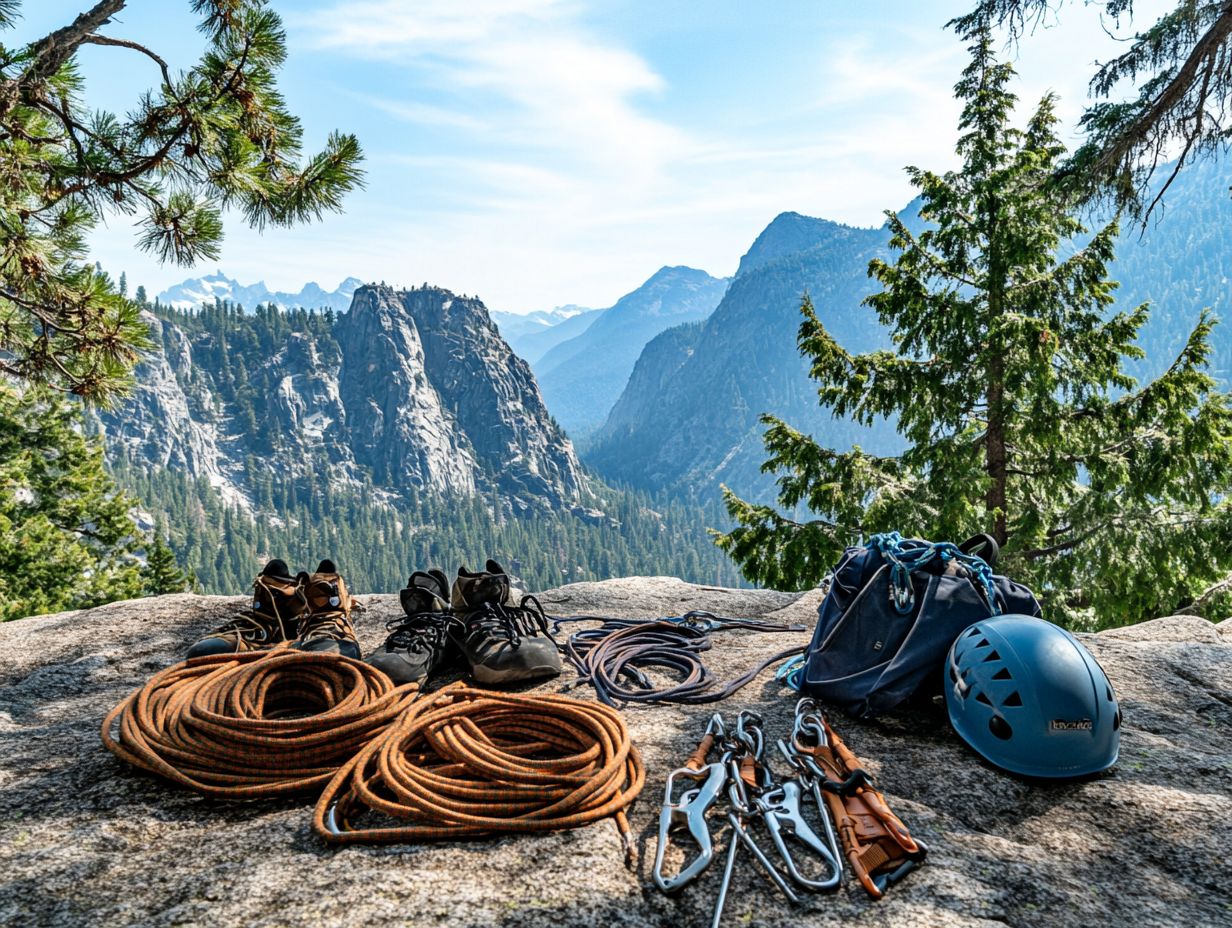
- Always consider the fit and size of climbing gear to ensure safety and comfort while on the wall.
- When choosing climbing shoes, take into account the type of climbing and your personal preference for style and material.
- A good climbing harness must have adjustable leg loops, sturdy construction, and proper fit for your body type.
1. Climbing Shoes
Climbing shoes are an essential piece of your climbing gear that significantly impacts your performance, comfort, and safety. Whether you’re a beginner or an experienced climber, the right pair is crucial as you navigate varied surfaces and conditions.
The right shoes improve your grip and precision. They also enhance your climbing skills, ensuring a superior experience at rock climbing gyms or outdoor venues like Yosemite or Red River Gorge, especially during those challenging climbs with tight placements.
You ll find various climbing shoes for different styles and preferences. From the specialized designs of La Sportiva, known for their unmatched sensitivity and support, to the durable models by Black Diamond, celebrated for their versatility, there’s something for everyone.
Never underestimate the importance of a perfect fit; shoes that are too loose or too tight can seriously hinder your performance and comfort on the rock face. If you’re just starting out, consider opting for shoes with softer rubber for better grip and comfort during your learning phase.
As technology advances, you’ll notice innovations like adjustable fit systems and breathable materials becoming more common. Plus, with trends shifting toward eco-friendly materials, you can feel good knowing your choices not only elevate your climbing experience but also positively impact the environment.
Get the right gear now to ensure your safety and boost your confidence on the rock!
2. Harness
A climbing harness is an essential piece of safety gear that provides the support, comfort, and security you need while climbing. It gives you the power to execute optimal climbing techniques and move efficiently on various surfaces.
Selecting the right harness, whether you’re just starting out or are an advanced climber, can significantly elevate your climbing experience and enhance your safety, especially during outdoor adventures or sessions at the climbing gym.
You’ll find several types of climbing harnesses on the market, each designed to meet different preferences and climbing styles.
- For example, sport climbers often gravitate toward harnesses with padded leg loops for added comfort during those long hangs.
- In contrast, those who engage in trad climbing (short for traditional climbing, which involves placing your own gear for protection) might look for models with multiple gear loops for easy access to their essential equipment.
Don t overlook features like adjustable waistbands that provide a tailored fit and breathable materials that wick away moisture.
Popular brands such as Petzl and Black Diamond present a variety of options, with user reviews emphasizing the versatility and durability of their harnesses, making them suitable for both novice and seasoned climbers alike.
3. Chalk Bag
A chalk bag is an essential accessory for climbers. It offers easy access to chalk, enhancing your grip and overall climbing performance.
Whether you’re climbing in a gym or scaling outdoor cliffs, a reliable chalk bag helps you maintain the best grip, which is crucial for your safety and technique.
You ll love the variety of styles and materials available. Choose one that perfectly aligns with your preferences and needs.
Options range from snug, lightweight designs that minimize bulk to larger, versatile bags that can hold extra gear. The choices are impressive!
Brands like Black Diamond, Petzl, and Mammut are well-regarded for their innovative designs. Many feature fleece-lined interiors for quick chalk access and convenient closures like drawstrings or toggles.
Don t miss out on the latest eco-friendly materials and customizable designs they’re perfect for climbers of all levels!
When selecting a chalk bag, consider size, fabric durability, and additional features, such as pockets for personal items. Making the right choice will elevate your climbing experience.
4. Carabiners
Carabiners are essential pieces of climbing hardware that establish a secure connection between your gear. They offer safety and reliability, whether you re conquering rock faces or tackling challenges in a climbing gym.
It s important to understand the different types of carabiners, including locking and non-locking varieties. This knowledge will significantly enhance your climbing experience.
You ll find various designs tailored for specific uses, such as oval, D-shape, and keylock carabiners. Each presents unique advantages suited to different climbing disciplines.
Locking carabiners provide extra security, making them ideal for lead climbing and belaying. Non-locking options, on the other hand, are lightweight and perfect for quickdraws.
When selecting carabiners, think about the climbing conditions and your specific needs. Consider factors like weight, strength ratings, and ease of use.
A reliable locking carabiner is invaluable for multi-pitch climbs, whereas non-locking carabiners excel on sport routes. Assess these factors to ensure you re well-equipped for your climbing adventures.
5. Belay Device
A belay device is an essential piece of climbing gear that allows you to control the rope while belaying. It plays a crucial role in safety and performance by ensuring a smooth, manageable rope system.
Choosing the right belay device can enhance your climbing techniques and significantly elevate your experience.
Among the most popular types are tube and assisted-braking devices. Each offers distinct features tailored for various climbing styles.
Tube devices are lightweight and straightforward. They provide reliable friction while allowing excellent control during lowerings and falls, making them perfect for sport climbing or single-pitch routes.
Conversely, assisted-braking devices, like the GriGri, provide an extra layer of security. They automatically engage during unexpected falls, reducing the risk of slips.
This distinction greatly affects how you manage rope tension, especially on multi-pitch climbs or when belaying heavier climbers. When selecting a device, consider your climbing preferences, the types of routes you tackle, and your experience level.
By doing so, you ll achieve optimal safety and performance!
6. Helmet
A climbing helmet is an essential piece of safety gear designed to protect against falling rocks and impacts. It significantly enhances your climbing safety and performance, especially in outdoor environments where conditions can be unpredictable.
Selecting the right helmet ensures maximum comfort and protection during your climbs. Make sure to try on your helmet for the perfect fit!
You’ll find a variety of climbing helmets available, including hard-shell models and foam options. Hard-shell helmets offer superior durability, making them perfect for rocky terrains. Foam helmets are lightweight and excel in shock absorption, particularly for sport climbing.
Many of these helmets come equipped with adjustable straps and ventilation systems to enhance fit and comfort. These two factors are crucial for those long climbs.
Noteworthy brands like Petzl, Black Diamond, and Mammut are celebrated for their high-quality climbing gear, known for durability and performance in even the most challenging conditions.
7. Quickdraws
Quickdraws are essential tools in your climbing arsenal. They enable you to connect the rope to anchors efficiently and play a pivotal role in your safety and performance as you tackle various climbing challenges.
You’ll find a variety of quickdraws, each tailored for specific climbing situations. From the classic version, which features biners connected by sturdy webbing, to sport quickdraws that employ a longer sling, there s a perfect fit for every climb.
Variations like keylock and wiregate designs help minimize snags and streamline your clipping efficiency. When choosing quickdraws, consider factors like weight, strength ratings, and gate mechanisms that align with your climbing style.
Proper usage is key; ensure the rope is positioned correctly and always maintain focus on safety checks. These practices are crucial for preventing accidents and enhancing your climbing experience.
8. Rope
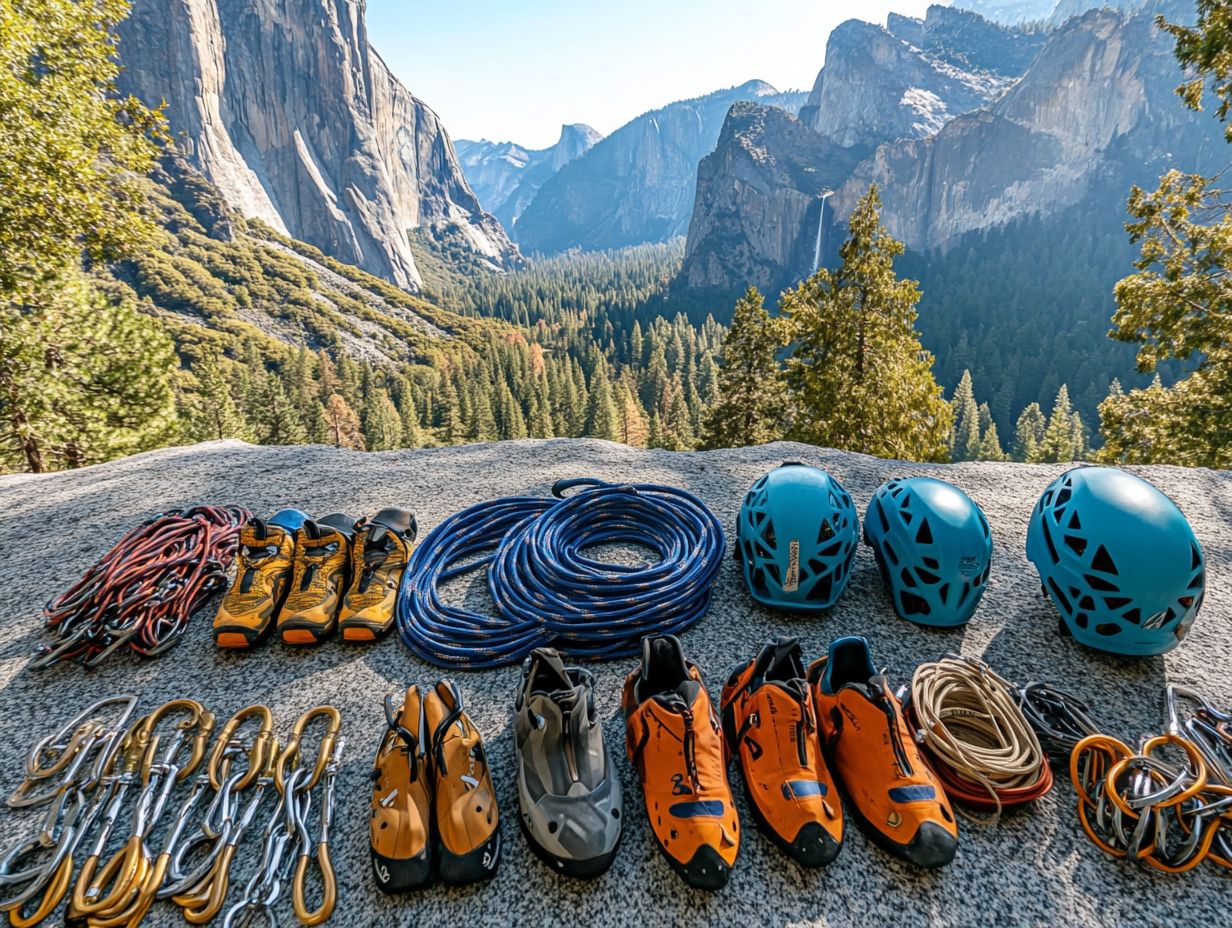
The climbing rope is arguably the most critical piece of safety gear in your kit. It serves as your essential lifeline during climbs, ensuring your overall safety and performance.
Choosing the right rope means understanding the different types available. Among the most common are dynamic and static ropes.
Dynamic ropes stretch to absorb energy during a fall, making them perfect for rock climbing. In contrast, static ropes do not stretch, making them ideal for activities like canyoning or rescue work, where a steady, stable line is crucial.
When selecting a climbing rope, consider factors like diameter and length. Thicker ropes provide greater durability but come with added weight.
Always check for safety certifications to ensure that your chosen rope meets industry standards for performance and reliability, ultimately enhancing your climbing experience.
9. Climbing Pants
Climbing pants are important gear for climbing. They provide the flexibility, durability, and comfort you need as you tackle diverse terrains and styles. The right pair not only enhances your climbing performance but also allows for an unhindered range of motion, whether you re scaling indoor walls or outdoor cliffs.
The best climbing pants are made from high-quality fabrics like nylon and spandex, striking a perfect balance between stretch and resilience. Look for features like a tapered fit or knees designed for better movement, which enhance your range of motion crucial for those intricate moves on the rock face.
Brands like Prana and Black Diamond offer various styles tailored to different climbing disciplines, from bouldering to alpine ascents. You can find the ideal fit that meets your specific needs. Pockets should be placed carefully to avoid interference with your harness, while breathable materials help regulate your temperature, making these pants adaptable to various weather conditions.
10. Climbing Shirt
A climbing shirt is a crucial element of your climbing wardrobe. It s crafted to deliver comfort, breathability, and moisture-wicking properties during outdoor adventures or gym sessions. Picking the right climbing shirt can make your climbs so much better, keeping you dry and comfortable throughout.
When searching for the perfect climbing shirt, pay attention to the fabric types. Lightweight synthetic materials excel in moisture management and dry quickly, while natural fibers like merino wool provide exceptional insulation and odor resistance.
Fit is equally important; look for a tailored, ergonomic cut that allows for unrestricted movement without feeling baggy.
Some popular brands that shine in climbing apparel include:
- Patagonia, renowned for its sustainable practices,
- Arc’teryx, celebrated for its durability and high-performance designs,
- PrAna, known for versatile options that transition effortlessly from climbing to casual wear, making them favorites among climbers.
11. Climbing Backpack
A climbing backpack is an essential companion for any climbing adventure. It offers storage while ensuring comfort and functionality during outdoor escapades or visits to climbing gyms. Choose the right climbing backpack to make your gear-carrying a breeze!
When selecting a climbing backpack, consider its size, typically ranging from 30 to 50 liters. This size provides ample space for ropes, harnesses, and other equipment without becoming a cumbersome burden.
Look for various compartments to enhance organization, allowing you to access your gear like carabiners or water bottles efficiently, without the frustration of sifting through a chaotic mix of items.
Comfort features such as padded shoulder straps and adjustable hip belts are essential for long routes. These elements help reduce fatigue, ensuring a more enjoyable climbing experience.
Depending on your individual climbing style whether it s bouldering, sport climbing, or tackling multi-pitch routes different backpacks cater to specific needs, simplifying your selection of the perfect gear for your next adventure.
12. Climbing Gloves
Climbing gloves are essential for climbers, providing necessary protection and grip to enhance both safety and performance on various surfaces. Choosing the right gloves can significantly improve your climbing techniques, enabling you to manage your gear more efficiently.
These gloves come in various styles tailored for different climbing disciplines, such as sport climbing, bouldering, and mountaineering. Some gloves feature reinforced palms and fingertips, designed to withstand wear and tear from rugged surfaces, while others use breathable materials for enhanced comfort during long climbs.
When it comes to grip, textured palms and silicone patterns are crucial, ensuring reliable contact with ropes and holds. Renowned brands like Black Diamond, Petzl, and Mammut offer a diverse range of designs to suit your preferences. Whether you prioritize dexterity or maximum protection, there s a glove tailored to meet your specific climbing needs.
Ready to gear up? Check out our top picks for climbing pants and enhance your next adventure!
13. Climbing Tape
Climbing tape is a must-have for all climbers. It is a great tool for your quest to prevent climbing injuries, providing support and protection for your fingers, hands, and other vulnerable areas that face the rigors of climbing.
Using climbing tape effectively boosts your performance and keeps you safer. Beyond mere protection against scrapes and cuts, the right application can significantly improve your grip, giving you the power, allowing you to tackle more challenging routes with unwavering confidence.
As you select your climbing tape, consider important factors such as thickness and how well the tape sticks that align with your unique climbing style.
Utilizing techniques like a special way of wrapping tape for better support can provide enhanced support while ensuring that your mobility remains unhindered. Opting for tape that tears easily can save you valuable time during climbs, allowing for swift rewraps whenever needed.
14. Climbing Helmet Light
A climbing helmet light is an essential accessory for anyone who dares to tackle low-light conditions. It significantly enhances your visibility and safety during challenging climbs.
These lights seamlessly work together with your climbing helmet, providing crucial illumination when navigating tricky terrain at night or in dimly lit areas. Having a reliable helmet light can truly make a world of difference in ensuring your safety.
With its glow, you ll gain a clearer view of potential hazards on the rock face, boosting your overall awareness of your surroundings.
When searching for the perfect helmet light, keep an eye out for these essential features:
- Lightweight design: Easy to carry during climbs.
- Adjustable beam settings: Customize your focus based on your needs.
- Weather resistance: Durable enough to handle outdoor elements.
These features help you tackle different outdoor conditions confidently. If you re serious about your climbing pursuits, investing in options like rechargeable LED lights or those boasting long battery life can greatly enhance your experience.
Brands such as Petzl and Black Diamond offer outstanding choices tailored for adventurers like you, ensuring you can conquer nighttime climbs with ease and confidence.
15. Climbing Guide Book
A climbing guidebook is an invaluable resource for you as a climber. It offers essential insights into climbing routes, techniques, and safety tips tailored to various climbing communities and locations.
Whether you’re just starting out or have years of experience, having a reliable guidebook enhances your climbing adventures, helping you navigate challenges with confidence. These guides typically feature detailed route descriptions that outline difficulty levels, approaches, and necessary gear.
Maps are another vital component, providing visual aids that help you efficiently locate trails and climbing spots. Safety information is prominently highlighted, offering crucial guidelines on weather conditions and potential hazards that can be lifesaving.
For rock climbing enthusiasts, resources like “Mountain Project” and “Outside Magazine” cater to diverse regions, whereas alpine climbers often gravitate toward “The American Alpine Journal” and “REI”.
Having a trustworthy guidebook at your side can truly make the difference between a routine climb and a memorable, safe adventure.
What to Consider When Choosing Climbing Gear?
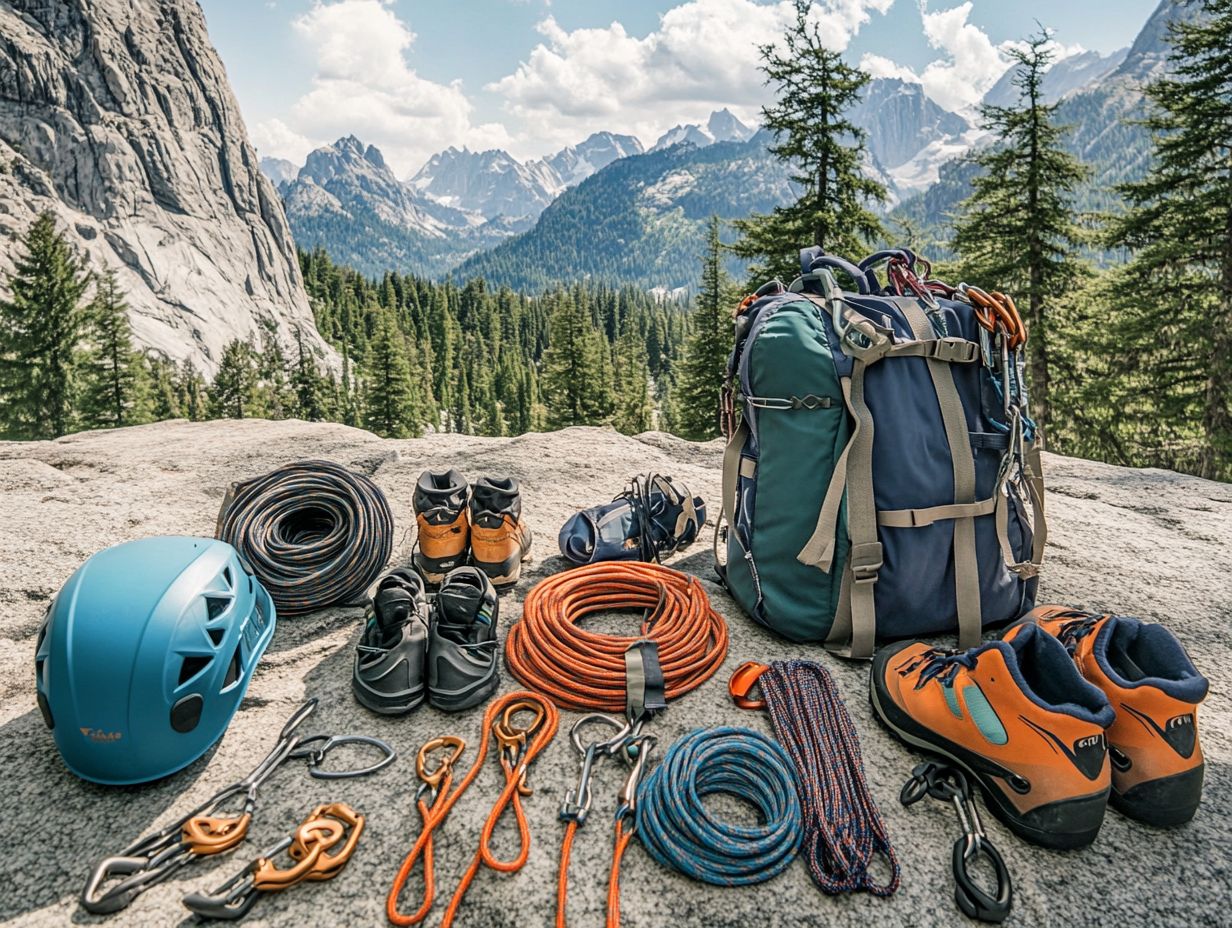
When selecting climbing gear, consider various factors that impact your safety and performance. Your equipment should fit your specific needs for outdoor adventures or climbing gym challenges.
Among the key factors you should prioritize are fit and comfort. Poorly fitting gear can lead to distractions and potential hazards. Understand the safety standards endorsed by reputable organizations to ensure the reliability of your equipment.
The quality and type of materials used will significantly influence durability and performance under different conditions. Assess the specific demands of different climbing styles from bouldering to mountain climbing to determine the most appropriate gear for your pursuits.
Engaging in gear testing and diving into user reviews can provide you with valuable insights. This will guide you in making informed decisions that cater to your individual preferences and requirements.
How to Determine the Right Size and Fit?
Determining the right size and fit for your climbing gear whether it s climbing shoes, harnesses, or climbing apparel is essential for maximizing your comfort, safety, and performance. Properly fitting gear enhances your climbing techniques and minimizes the risk of climbing injuries.
To achieve that ideal fit, it s vital to try on various brands, as sizing can vary significantly. When selecting climbing shoes, aim for a snug fit that limits movement while still allowing for circulation.
For harnesses, look for adjustable leg loops and a comfortable waist belt. Brands like Black Diamond and Petzl offer fantastic options that strike a balance between weight and durability.
Regarding climbing clothing, prioritize flexibility and breathability. Brands such as Prana and Arc’teryx deliver high-quality outfits specifically designed for unrestricted movement.
Don’t wait try your gear before you hit the rocks! Always test your gear by moving through climbing-specific motions to gauge comfort and ensure you have a full range of motion.
What Are the Different Types of Climbing Shoes?
Climbing shoes come in various types, each crafted for specific climbing styles and techniques. Understanding these types empowers you to select the right shoes that enhance both your climbing skills and comfort.
You ll find three main categories:
- Aggressive shoes: Extreme downward camber, perfect for sport climbing or bouldering.
- Moderate shoes: An ideal balance between comfort and performance, suitable for multi-pitch climbs and all-day wear.
- Neutral shoes: Maximum comfort, great for beginners or those tackling long routes.
Your choice of climbing shoe can significantly affect your grip, precision, and overall stability. For instance, an aggressive shoe like the La Sportiva Theory might optimize your performance on overhangs, while a neutral fit from brands like Five Ten provides the support needed for lengthy multi-pitch adventures, ensuring you remain comfortable without compromising safety.
What Are the Key Features of a Good Climbing Harness?
A quality climbing harness prioritizes comfort, safety, and functionality. These features boost your climbing performance and provide ultimate freedom of movement on various surfaces.
Key components like generous padding reduce pressure points. This allows you to wear the harness comfortably for long periods.
Gear loops offer practical storage for your climbing tools. They ensure your gear is easily accessible when you need it the most.
Adjustability is crucial for a snug fit. It accommodates different body shapes and clothing layers seamlessly.
Brands like Black Diamond, Petzl, and Arc’teryx offer popular harness options. These options masterfully combine features to support your safety and performance during every adventure.
How to Choose the Right Belay Device for Your Needs?
Choosing the right belay device is vital for your climbing safety. It directly influences how you manage the rope and respond to climbing situations.
Understanding the different types of belay devices will empower your choice. Each type complements specific climbing techniques and enhances your performance.
There are tubular devices that provide versatility and assisted-braking models that offer added security. If you often engage in sports climbing, choose a device for quick catches and smooth rope feeding.
Consider how often you climb, the weight of the device, and your preferences. These factors are crucial for a safe and enjoyable climbing experience.
Understanding the braking mechanisms of each device significantly boosts your safety on the route.
What Are the Different Types of Climbing Helmets and Their Uses?
Climbing helmets come in various types, each designed for specific uses and environments. They provide crucial protection and enhance your safety while climbing.
For example, multi-sport helmets are versatile for activities like rock climbing and biking. They allow you to use one helmet for multiple sports.
Hard-shell helmets offer strong protection, making them ideal for technical climbing and situations with falling debris.
If you prefer something lighter, foam helmets are great for indoor climbing and activities with lower impact risks. Recognizing these types helps you choose based on your discipline and safety preferences.
What Are the Essential Features of a Climbing Backpack?
An effective climbing backpack is essential, packed with features that elevate its usefulness for carrying gear while ensuring ease of use and comfort during your outdoor adventures. Understanding these key elements will help you confidently choose the perfect backpack tailored to your needs.
One of the foremost aspects to consider is the volume and organizational pockets of the backpack; this directly impacts how much gear you can comfortably carry. Organizational pockets are crucial for quick access to essentials like chalk, snacks, or emergency gear. Padded comfort straps help distribute weight evenly, reducing strain during long treks.
Look for reinforced areas that protect against the wear and tear of rough terrain. Among the standout options available, consider the Osprey Mutant and Black Diamond Speed 40 for their durability and versatility, or the Black Diamond Speed 40, which combines a lightweight design with functional features, making it a superb choice for advanced climbing escapades. For those seeking a streamlined approach, check out the best hiking gear for minimalists.
How to Choose the Right Climbing Rope for Your Adventure?
Choosing the right climbing rope and equipment is crucial for your safety and performance. With various types of ropes tailored for different climbing conditions and activities, understanding the specifics can significantly aid you in making informed decisions about your gear.
Among the most common options, you ll find dynamic ropes, which stretch under load and are ideal for rock climbing and lead climbing. On the flip side, static ropes have minimal stretch, making them perfect for rescue operations and rappelling, where stability is paramount.
Consider factors such as diameter, which can directly influence your grip and the rope s weight. Thinner ropes are lighter, but they might not handle heavy impacts from falls, making belay devices crucial for safety. Additionally, the length of your rope should be chosen based on the climbing routes you plan to tackle, ensuring you have just the right amount without unnecessary bulk.
Ultimately, understanding these nuances will not only enhance your climbing experience but also bolster your safety on the rock face, ensuring you have the best gear for cross-country hiking as well.
What Are Some Tips for Choosing Comfortable and Durable Climbing Clothing?
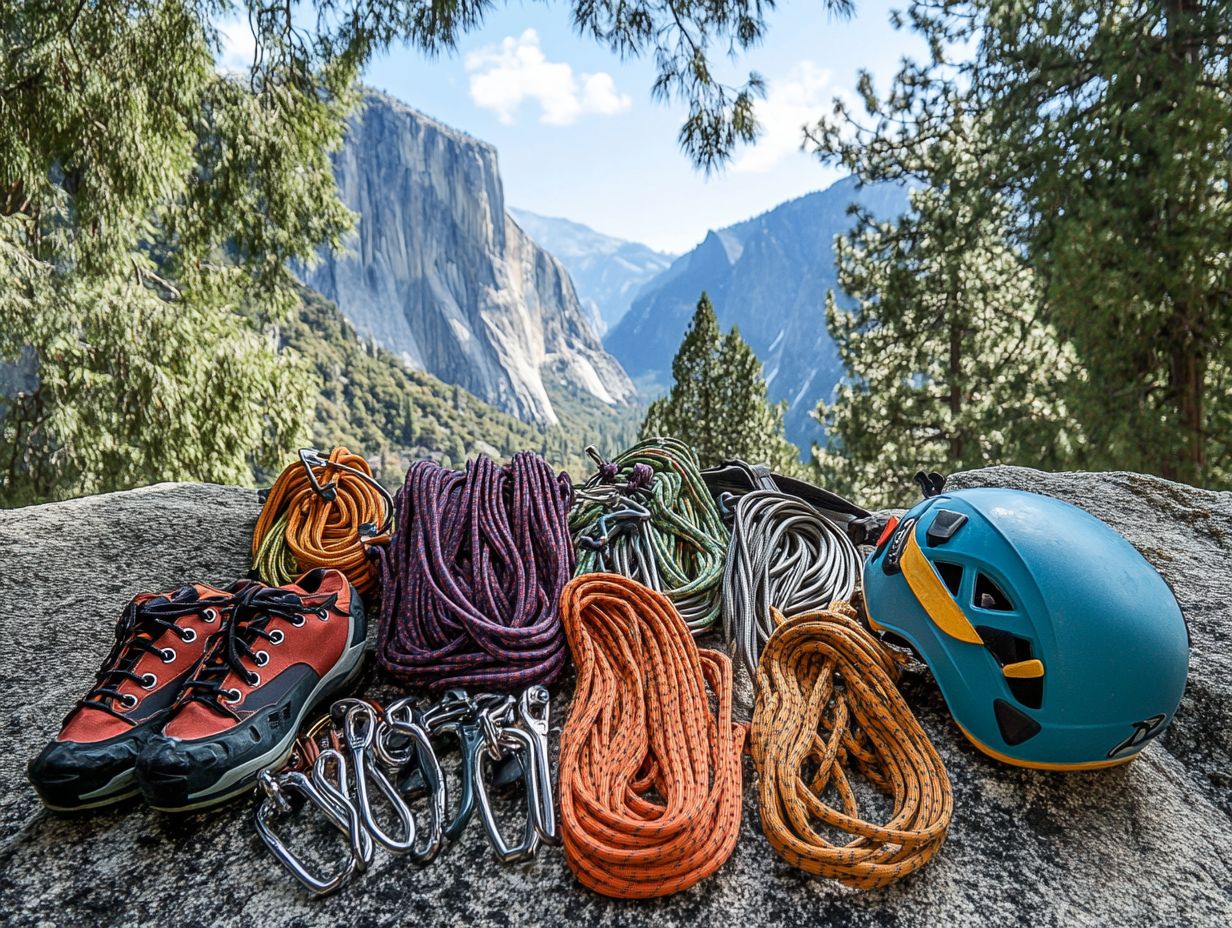
Choosing comfortable and durable climbing clothing is essential for elevating your performance and ensuring you can move freely during climbs, whether you’re tackling walls indoors or scaling cliffs outdoors. By understanding the key features and materials, you can select the best apparel tailored to your activities, as climbing conditions can vary significantly across different surfaces.
When selecting shirts, look for breathable fabrics that wick moisture; they are crucial for maintaining a comfortable body temperature while you re on the move. For pants, prioritize those that offer a good fit and stretch, allowing for unrestricted mobility on challenging routes. Base layers, along with brands like La Sportiva and Petzl, play a vital role in temperature regulation, so opt for options made from merino wool or synthetic blends to keep you comfortable.
In terms of brands, consider Patagonia, Prana, and The North Face, alongside Black Diamond and Metolius; they are renowned for their high-quality climbing gear, including affordable options for beginners that combine durability with functionality. Additionally, look into the top hiking gear accessories you need to keep these tips in mind as you focus on both comfort and performance, ensuring that the right gear enhances your overall climbing experience.
Frequently Asked Questions
What is the best climbing gear for outdoor adventures?
The best climbing gear includes climbing shoes, a harness, a rope, carabiners, and quickdraws. These essentials are necessary for every climber s toolkit.
What should I look for when buying climbing shoes?
Look for a snug fit, good grip, and durable materials. These features ensure optimal performance and safety.
Can I use any rope for climbing?
No, not all ropes are suitable. Use a dynamic rope, specifically made for climbing, to absorb impact if you fall.
Why is a harness important for outdoor climbing?
A harness distributes the climber’s weight and provides a secure attachment for the rope. This ensures safety while scaling rocks and mountains.
What are quickdraws and why are they necessary?
Quickdraws connect the rope to the bolts on the rock using two carabiners and a sling. They help reduce rope drag and offer quick protection while climbing.
Should I invest in high-quality climbing gear?
Investing in high-quality gear is crucial for your safety and performance. Low-quality gear can jeopardize your climbing experience!

